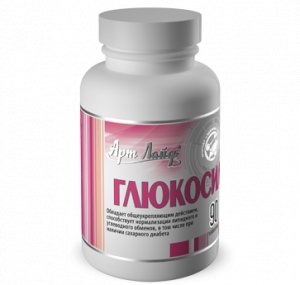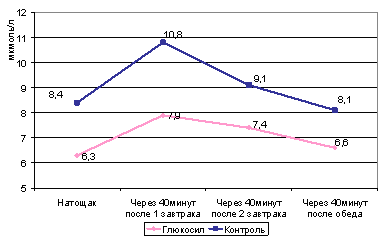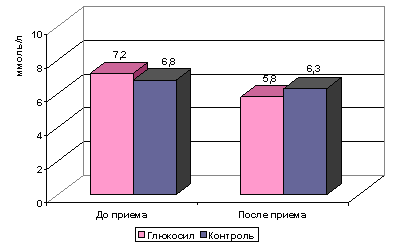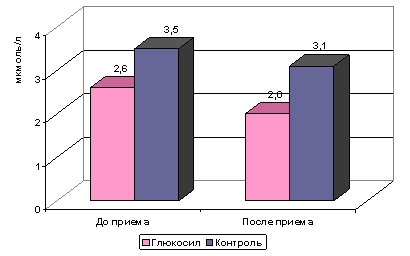Glyukosil
The role of carbohydrates in a person's life can not be overestimated. This is one of the most important nutritional components. These substances have a sweet taste and sweet tooth has deep evolutionary roots. At the dawn of its development, people realized that the food, the taste gives a significant amount of energy.
The reason is that glucose, which is a structural unit of all carbohydrates - is a basic and universal energy currency for all cells. It is needed because as water and oxygen.
Glucose, once a cell undergoes a series of chemical reactions, and eventually breaks up water molecules and carbon dioxide are removed from the body. Released as a result of these reactions is the energy stored by the body in the form and ensures its viability.
In some tissues glucose can penetrate itself, for example, the brain can use it as an energy source (and only her!), And glucose uptake brain does not need "helpers". Only a molecule of glucose, and for its assimilation brain does not need the hormone insulin
Most of other organs and tissues are insulin dependent, that is, for the full assimilation and processing of glucose by cells requires the presence of the hormone of the pancreas - insulin. When his disease (diabetes mellitus type 1) or a violation of the mechanism of interaction of insulin with cells of the body (diabetes mellitus type 2), glucose accumulates in the blood in large quantities, and most of the body's cells lose their main source of energy. Without insulin, the cell membrane permeability for glucose decreases by 20 times, and cells die from hunger, and dissolved in the blood of excess sugar poisons the body.
In 2005, there were more than 150 million people with diabetes. About 15% of these people suffer from diabetes, the first type - in their pancreas, insulin is not synthesized at all or is produced in extremely small quantities. The most likely cause of this type of diabetes is a failure in the immune system: lymphocytes begin to destroy cells in the pancreas that synthesize insulin, mistaking them for enemies. The remaining 85% have diabetes of the second type. - Insulin in their body produces, but also partially or completely no effect on the cell membrane. Most often, a violation of synthesis of membrane proteins - insulin receptors associated with chronic overeating and obesity.
In this form of diabetes can keep myself in relatively good condition due to a low calorie diet with minimal carbohydrates, in the case of appointment of a doctor - to take medications that reduce blood glucose levels. But as you know, the best treatment - is prevention, especially in connection with the fact that growing numbers of immunity cells to insulin - insulin resistance.
In developing this condition plays a major role of skeletal muscle inactivity. In healthy people, up to 80% of all incoming glucose utilized by skeletal muscle. Given the level of inactivity in today's society, it must take steps to maintain the physiological state of glucose metabolism by substances of natural origin, since insulin resistance increases the risk of diabetes, especially against the background of genetic predisposition to it
In order to prevent the development of the pathology of metabolism, including carbohydrates, you should:
• Exercise regularly, give load skeletal muscle
• Eat right, avoid excessive consumption of sugar and animal fat
• Ensure the active uptake of glucose by cells and the preservation of their insulin sensitivity with bioactive phytocomplex.

Ideal for this purpose, the complex Glyukosil from the Company Artlife . It was created to optimize blood glucose levels and normalization of carbohydrate and fat metabolism, as well as rehabilitation and support for the functional activity of cells in the pancreas
The complex allows it to carry out soft, but the efficient support and correction of metabolic disorders. Then - on the table.
|
Ingredient |
Action |
|
Blueberries |
Antioxidant, sosudoukreplyayuschee, saharoponizhayuschee |
|
Birch |
Diuretic, antibacterial, disinfectant |
|
Cowberry |
Antimicrobial, diuretic, astringent and anti-inflammatory |
|
Artichoke |
Holesterinoponizhayuschee, choleretic, antiseptic |
|
Tutsan |
Astringent, anti-inflammatory, tonic, antispasmodic |
|
Nettle |
Astringent, diuretic, hemostatic, immunostimulatory |
|
Nard |
Anti-inflammatory, choleretic, regulating digestion |
|
Knot-grass |
Antioxidant, tonic, anti-diuretic |
|
Peppermint |
Sedative, antispasmodic, analgesic |
|
Burdock |
Diuretic, antitoxic, stimulating tissue regeneration |
|
Raspberry |
Diaphoretic, antipyretic, anti-glyukozoreguliruyuschee |
|
Sagebrush |
Antimicrobial, antihelminthic, anti-inflammatory |
|
Ginger |
Antioxidant, anti-inflammatory, antispasmodic |
|
Garlic |
Saharoponizhayuschee, diuretic, strong antihelminthic, antiviral and antimicrobial, analgesic |
|
Ginkgo biloba |
Vasodilation, the strengthening of the venous wall, improving metabolism |
|
Oktakozanol |
Antigypoksytic, holesterinoponizhayuschy, improves carbohydrate metabolism in muscle |
|
Papain |
Proteolytic, anti-inflammatory, immunomodulatory |
|
Bromelain |
|
|
Vitamins A, E, C |
Antioxidant, sosudoukreplyayuschee, anti kollagenoobrazuyuschee |
|
B vitamins (B1, B2, B6, B3, B5, biotin) |
Normalization of fat and carbohydrate metabolism, support the structure of the peripheral nerves, preventing violations of sensitivity and diabetic neuropathy |
|
Vitamin B12 and folic acid |
Antigipoksicheky, antianemic |
|
Vitamin D |
Provides calcium absorption and increases bone density |
|
Rutin, quercetin |
Anti-inflammatory, anti, sosudoukreplyayuschee, protivoskleroticheskoe, antiallergic, mild antispasmodic |
|
Zinc |
Immunostimulant, ïðîòèâîàòåðîñêëåðîòè÷åñêîå, promotes protein synthesis |
|
Manganese |
Regulating metabolism, insulin metabolism, cholesterol |
|
Chrome |
Saharoreguliruyuschee, restores normal glucose tolerance, increases the sensitivity of cells to insulin |
|
L-Carnitine |
Liporeguliruyuschee, normalize lipid metabolism in the liver, improves energy security muscle |
|
Coenzyme Q 10 |
Antioxidant, provides energy production at the cellular level |
The effectiveness of the complex is clinically proved. In tests of the complex was attended by 98 patients with type 2 diabetes aged 47 to 60 years and with disease duration from 3 to 25 years. The study group included 44 patients, they take complex Glyukosil "against saharoponizhayuschey pharmaceutical therapy, the control group was composed of 44 persons who received only drug therapy. Course of follow-up was 1 month.
By the end of the second week patients received complex Glyukosil "marked improvement of health, reduction of thirst and dry mouth, and by the end of the observation was to note their reduction in body mass index.

Fig. The dynamics of body mass index in patients studied with type 2 diabetes.
Investigation of glucose in capillary blood glucose and postprandial showed that by the end of a course taking complex Glyukosil "in patients taking it decreases blood glucose levels, suggesting a more fulfilling its assimilation by cells of the body.

A) the beginning of observation

B) The end of the observation
Fig. Dynamics of blood glucose fasting and after meals in the examined patients with type 2 diabetes
Normalization of carbohydrate metabolism under the influence Complex Glyukosil "entailed positive changes of fat metabolism, in particular, there was a reduction in total cholesterol in patients taking complex Glyukosil"

Fig. Dynamics of total cholesterol in the blood of fasting and after ingestion of the surveyed patients with type 2 diabetes
The high content of triglycerides in the blood indicates a poor prognosis for diabetes. Reduction of these substances under the influence of exchange rate reception of "Glyukosil" in relation to the initial indicators of triglycerides in the blood indicates the deterrent effect of the complex against the negative dynamics of diabetes.

Fig. Dynamics of the content of triglycerides in the fasting and postprandial have examined patients with type 2 diabetes
Scientifically-based combination of ingredients, complex Glyukosil, balanced, taking into account dietary habits, physical activity and body's needs, helps optimize the level of glucose in the blood, improves the function of the pancreas and the digestive system as a whole, activates the microcirculation, it normalizes carbohydrate and fat metabolism.
Indications for the use of "Glyukosil" serve the following states:
· prevention and correction of body functions in diabetes mellitus type I and II of varying severity, as well as impaired glucose tolerance
· need to optimize the carbohydrate-lipid metabolism
· decrease the function of the pancreas and the digestive system as a whole
· prevention of atherosclerotic changes in vessels
· Chronic noncommunicable diseases of the gastrointestinal tract
